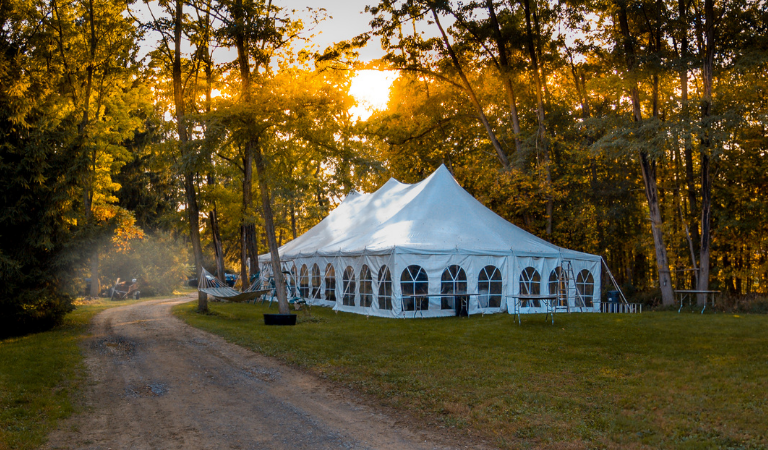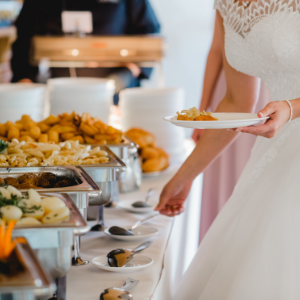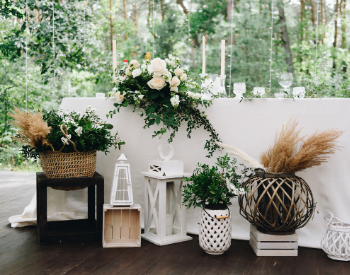Whether you’re planning a wedding for yourself or a client, you’ll want to know all the details on how to organize a spectacular wedding reception. Weddings typically consist of two parts: the ceremony and the reception. While the ceremony might be the most special part of the celebration, the reception is the party and what guests will look forward to the most. However, the reception might be the most difficult of the two because it consists of so many components. This is why it is important to meticulously plan your wedding reception to a point where it works without you having to supervise or worry about anything. To make things easier, read through this guide to help you plan the perfect wedding reception.
Before You Begin, Ask Yourself:
What Type Of Wedding Will I Be Hosting?
There are usually three types of weddings:
- Indoor
- Outdoor
- Destination
How Big Is My Budget?
Determining the size of your budget will help you make all of your wedding decisions. Keep in mind to put most of your money towards food and drinks.
Will I Be Hiring A Wedding Planner?
A wedding planner can be a great help to you with their know-how and can take the stress off of planning for your wedding. On the other hand, if you are planning the wedding and reception yourself, make sure you have plenty of time to do all of the research required before you begin making any major decisions. For instance, if you plan to make all of the food yourself, take time to learn and perfect each recipe.

Picking A Venue
What Type Of Venue Should I Look For?
Your wedding reception venue should be able to comfortably accommodate the number of people you plan on inviting. A great way to save money would be to have your ceremony and reception in the same venue and have your wedding take place during the typical off-season, which is January through April and November. Also, if you are planning an outdoor wedding, tents are must-haves. No matter how sunny and clear the forecast may be, you should always have a tent big enough for all of your guests and vendors.
Wedding Venue Features
Visit potential venues and ask if the owner or manager can give you a walk-through of the whole site. Take this opportunity to ask the venue owner about the space, such as their cocktail area and dance floor. Ask if the venue site offers extra services such as catering, DJ’s, chairs, and tables. They will usually offer great deals for the price of their services.
Creating A Seating Chart
Before you create a seating chart, wait until most of your guests have RSVP’d. This will give you a better idea of how big or small your venue should be. When creating a seating chart, seat people who know each other close together. This will help get the conversation and fun going at your reception.
Feeding Your Guests
If you’ve got a tight budget, self-catering is probably the best way to save money. If you don’t have time to self-cater your wedding, traditional catering is a great and always reliable option. Whatever you decide for the big day, there are a few things you need to consider when deciding what type of food to serve.
- Testing Samples: If you decide to hire a caterer, make sure you get to taste samples of their dishes. By trying out the chef’s meals, you can include the best meals your caterer has to offer and impress guests.
- Allergies & Dietary Restrictions: You should ask your guests if they have any allergies or dietary restrictions. This way, you can offer vegan meals or allergen-free foods to guests with any health conditions.
- One Dish: If you’re on a budget, you always have the option to serve only one dish for all of your guests. Just make sure it doesn’t affect anyone’s allergies or dietary restrictions.
- Cultural Dishes: If you have family or friends coming from a certain country, offer dishes from their respective countries in case they do not like the dishes in your area.
- Cocktail Hour: It is common to offer a cocktail hour before the reception. This encourages guests to mingle while enjoying delicious cocktails.
- Food Stations: A new trend in wedding receptions is including unique food stations such as an ice cream bar or bacon bar. They are a great way to keep guests munching on snacks throughout the reception.
- Feed Your Vendors: Your photographer, DJ, or caterer will be working for hours during mealtimes and will need food to help make it through the reception. Make sure there is also enough food for them by the time they take their break.
- To Go Boxes: At the end of the meal, offer guests to go boxes so guests can take their leftovers home and eliminate food waste.
Create A Timeline
Now that you have picked your caterer and finalized your menu, it’s time to create an itinerary or timeline of your reception. Creating one is crucial for you and your vendors, especially if you have rented the venue for a limited amount of time and want to keep vendors from charging extra hours. The order of wedding reception events are usually scheduled in the following manner:
- Bride and groom introductions
- Toasts
- Lunch/Dinner
- Bride and groom dance
- Father/daughter dance or mother/son dance
- Open dance floor
- Cutting the cake
- Bouquet toss
- Garter removal/toss
- Last dance
- Send off
When creating your itinerary, keep in mind the amount of time between each event. For instance, you don’t want guests waiting too long for their meals as they might get hungry after a certain amount of time. Make sure to give a copy of your timeline to each of your vendors so they know exactly what time they are expected to serve your guests.
Decorations
Since it’s your day, you can choose to decorate your reception however you want. If you have an ongoing theme, make sure to carry it over to your reception for consistency. Pick out a color scheme and choose the flowers and centerpieces based on those colors. Remember, flowers are just an option and can get pricey. Instead, you can choose to go with candles or balloons. As mentioned, the decorations are totally up to you, so you can go as small or as big as you want.
Entertainment
Typically, a wedding will feature a DJ or a cover band as entertainment. No matter what you decide, remember that music is an essential part of any celebration. You will need to have music playing for most of the night to avoid any dead silence. Work with your DJ or band and go through the timeline to help figure out when you should be playing music. Music is usually played during these parts of a reception:
- Cocktail hour: Showcase music by unknown artists, b-sides, or new music to give guests conversation starters.
- Dinner: Play music that is light or music that you would like to hear while eating. You can also ask your DJ to read the crowd and let them decide what music to play.
- Dancing: Choose songs for the first/last dance or dance with the parents. When it comes to opening up the dance floor, you can create a playlist of songs you know guests will want to hear but remember to give your band or DJ a chance to showcase their skills.
Make It Special
As long as you cover the aforementioned components, you will have everything you need to pull off the perfect wedding reception. However, don’t be afraid to mix things up a little and add in your own spin on a wedding reception. This will make your celebration truly unique and memorable.









